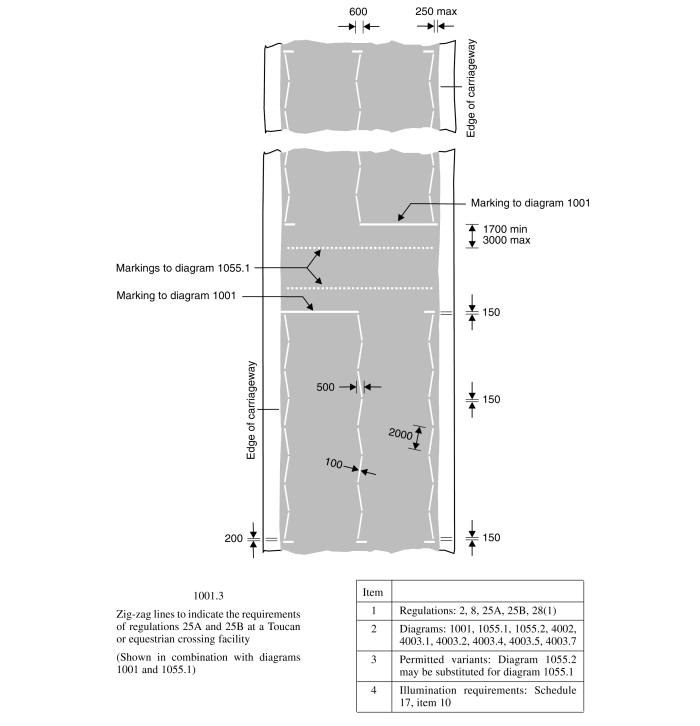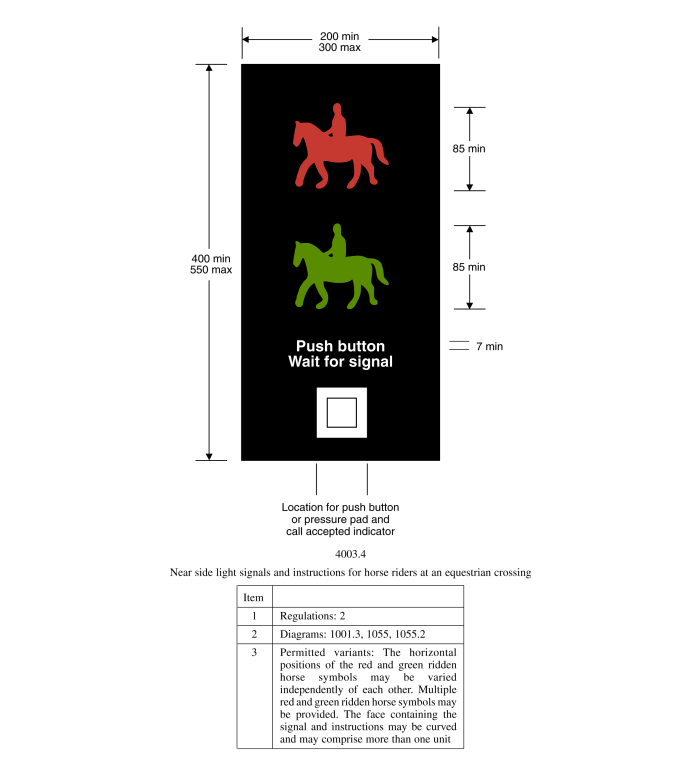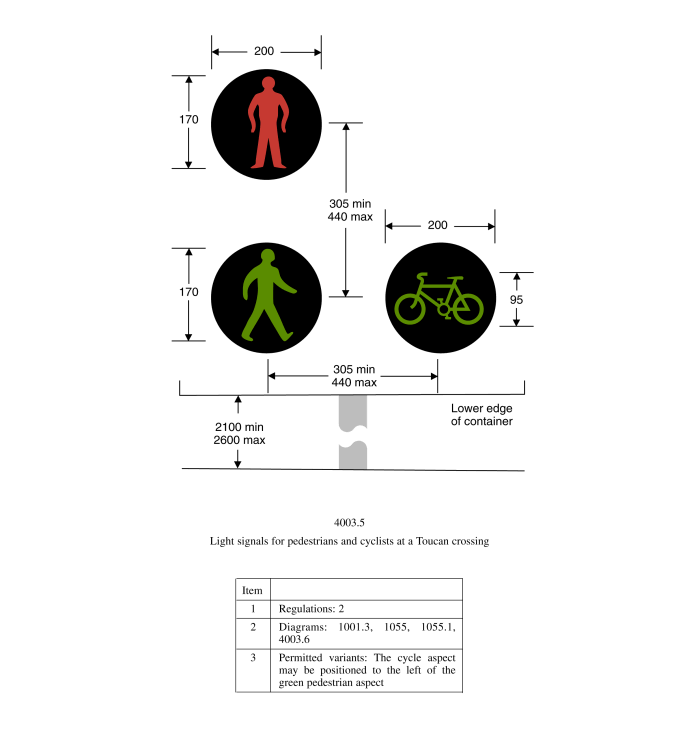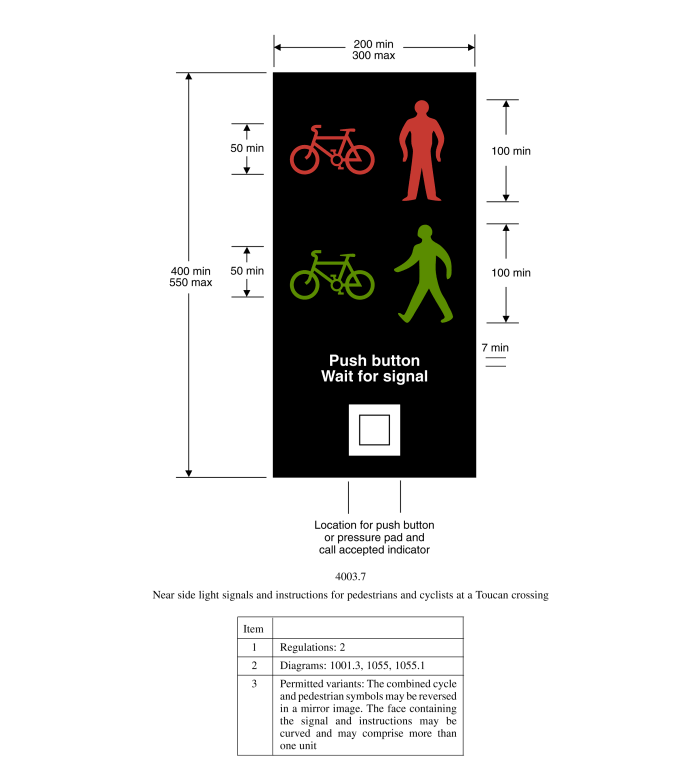Freely Available British and Irish Public Legal Information
[Home] [Databases] [World Law] [Multidatabase Search] [Help] [Feedback]
Statutory Rules of Northern Ireland
You are here: BAILII >> Databases >> Statutory Rules of Northern Ireland >> The Traffic Signs (Amendment) Regulations (Northern Ireland) 2005 No. 428
URL: http://www.bailii.org/nie/legis/num_reg/2005/20050428.html
[New search] [Help]
| Made | 21st September 2005 | ||
| Coming into operation | 7th November 2005 |
The Department for Regional Development[1], in exercise of the powers conferred by Article 50(5) of the Road Traffic (Northern Ireland) Order 1995[2] and Article 28(2) and (4) of the Road Traffic Regulation (Northern Ireland) Order 1997[3] and now vested in it[4] and of all other powers enabling it in that behalf hereby makes the following regulations:
Citation and commencement
1. These Regulations may be cited as The Traffic Signs (Amendment) Regulations (Northern Ireland) 2005 and shall come into operation on 7th November 2005.
Amendments
2. —(1) The Traffic Signs Regulations (Northern Ireland) 1997[5] shall be amended as provided by paragraphs (2) to (14).
(2) In regulation 2 (interpretation – general) –
-
(a) after the definition of "dual carriageway road" there shall be inserted the following definitions –
-
"
"EEA Agreement" means the Agreement on the European Economic Area signed at Oporto on 2nd May 1992 as adjusted by the Protocol signed at Brussels on 17th March 1993[6];
-
"EEA Standard" means –
-
(a) a standard or code of practice of a national standards body or equivalent body of any EEA State;
(b) any international standard recognised for use as a standard or code of practice by any EEA State; or
(c) a technical specification recognised for use as a standard by a public authority of any EEA State,
and a reference to a "corresponding EEA Standard", in relation to a British or European Standard, is a reference to an EEA Standard which requires a level of performance equivalent to that required by the British or European Standard;
-
"EEA State" means a State which is a contracting Party to the EEA Agreement;
-
"equestrian crossing" means a place on the carriageway of a road –
-
(a) where provision is made for equestrian traffic to cross the carriageway; and
(b) whose presence is indicated by a combination of –
-
(i) traffic light signals to control vehicular traffic of the kind prescribed by regulation 30;
(ii) the signals shown in diagrams 4003.2 and 4003.3, or the signal shown in diagram 4003.4; and
(iii) the road marking shown in diagram 1055.1 or 1055.2;";
(b) after the definition of "sign" there shall be inserted the following definitions –
-
"
"signal-controlled crossing facility" means –
-
(a) an equestrian crossing;
(b) a signal-controlled pedestrian facility; or
(c) a Toucan crossing;
-
"signal-controlled pedestrian facility" means a place on the carriageway of a road –
-
(a) which is not a "pedestrian crossing" established under Article 59(1) of the 1997 Order;
(b) where provision is made for pedestrians to cross the carriageway; and
(c) whose presence is indicated by a combination of –
-
(i) traffic light signals to control vehicular traffic of the kind prescribed by regulation 30;
(ii) the signals shown in diagrams 4002 and 4003, or the signal shown in diagram 4003.1; and
(iii) the road marking shown in diagram 1055.1 or 1055.2;";
(c) after the definition of "temporary statutory provision" there shall be inserted the following definition –
-
"
"Toucan crossing" means a place on the carriageway of a road –
-
(a) where provision is made for both pedestrians and pedal cyclists to cross the carriageway; and
(b) whose presence is indicated by a combination of –
-
(i) traffic light signals to control vehicular traffic of the kind prescribed by regulation 30;
(ii) the signals shown in diagrams 4003.5 and 4003.6, or the signal shown in diagram 4003.7; and
(iii) the road marking shown in diagram 1055.1 or 1055.2;"; and
(d) after the definition of "with-flow lane" there shall be inserted the following definition –
-
"
"zig-zag line" means a road marking of the size, colour and type shown in diagram 1001.3 which has been placed along a length of carriageway adjacent to a signal-controlled crossing facility.".
(3) In regulation 8 (application of Article 50 of the Road Traffic (Northern Ireland) Order 1995 to signs and disqualification for offences) in both paragraphs (1) and (2), after sub-paragraph (a) there shall be inserted the following sub-paragraph –
-
"
(aa) the road marking shown in diagram 1001.3;".
(4) In regulation 9 (signs and markings to be of the sizes, colours and types shown in the diagrams) in paragraph (4) for the words "diagram 1055" there shall be substituted the words "diagrams 1055.1 and 1055.2".
(5) After regulation 25 (road markings shown in diagrams 1013.1 and 1013.3 and their significance) there shall be inserted the following regulations –
-
"
Road marking shown in diagram 1001.3: zig-zag lines – no stopping
25A. —(1) In this regulation and regulation 25B –
-
"controlled area" means a length of carriageway –
-
(a) which is adjacent to a signal-controlled crossing facility and has a zig-zag line marked along each of its edges (with or without zig-zag lines also marked down its centre); and
(b) in or near which no other signs or markings have been placed except ones comprised in the combination of signs and markings indicating the presence of the facility or shown in diagram 610, 611, 612, 613, 616, 810, 1029 or 1062; and
-
"vehicle" does not include a pedal bicycle not having a sidecar attached to it, whether or not additional means of propulsion by mechanical power are attached to the bicycle.
(2) Subject to paragraph (3) and without prejudice to regulation 25B, a zig-zag line shall convey the requirement that the driver of a vehicle shall not cause any part of it to stop in the controlled area in which it is marked.
(3) Paragraph (2) does not prohibit the driver of a vehicle from stopping it in a controlled area –
-
(a) if the driver has stopped it for the purpose of complying with an indication given by a light signal for the control of vehicular traffic or the direction of a constable or a traffic warden;
(b) if the driver is prevented from proceeding by circumstances beyond his control or if it is necessary for him to stop to avoid injury or damage to persons or property;
(c) when the vehicle is being used for police, fire brigade or ambulance purposes;
(d) for so long as may be necessary to enable the vehicle to be used for the purposes of –
-
(i) any operation involving building, demolition or excavation;
(ii) the removal of any obstruction to traffic;
(iii) the maintenance, improvement or reconstruction of a road; or
(iv) the laying, erection, alteration, repair or cleaning in or near the controlled area of any sewer or of any main, pipe or apparatus for the supply of gas, water or electricity, or of any telecommunication apparatus as defined in section 4(3) of the Telecommunications Act 1984[7];
(e) if he stops the vehicle for the purpose of making a left or right turn; or
(f) if the vehicle is a bus, other than one being used on an excursion or tour, which is stopped at a bus stop after having proceeded through the crossing to which the controlled area relates, and is waiting in that area in order to take up or set down passengers.
Road marking shown in diagram 1001.3: zig-zag lines – no overtaking
25B.
—(1) Without prejudice to regulation 25A, a zig-zag line shall convey the requirement that, whilst any motor vehicle (in this regulation called "the approaching vehicle") or any part of it is within the limits of a controlled area and is proceeding towards the signal-controlled crossing facility to which the controlled area relates, the driver of the vehicle shall not cause it or any part of it –
-
(a) to pass ahead of the foremost part of any other motor vehicle proceeding in the same direction; or
(b) to pass ahead of the foremost part of a vehicle which is stationary for the purpose of complying with the indication given by a traffic light signal for controlling vehicular traffic.
(2) In paragraph (1) –
-
(a) the reference to a motor vehicle in sub-paragraph (a) is, in a case where more than one motor vehicle is proceeding in the same direction as the approaching vehicle in a controlled area, a reference to the motor vehicle nearest to the signal-controlled crossing facility to which the controlled area relates; and
(b) the reference to a stationary vehicle is, in a case where more than one vehicle is stationary in a controlled area for the purpose of complying with the indication given by a traffic light signal for controlling vehicular traffic, a reference to the stationary vehicle nearest to the signal-controlled crossing facility to which the controlled area relates.".
(6) In regulation 30 (use of different types of light signals) in paragraph (2) for the words "places where pedestrians or horses cross the road (other than Pelican crossings)" substitute "signal-controlled crossing facilities".
(7) For regulation 38 (light signals for equestrian traffic) and its heading there shall be substituted the following regulations –
-
"
Light signals at equestrian crossings
38. —(1) In this regulation "the crossing" in relation to a sign means the equestrian crossing in relation to which the sign is placed.
(2) A sign for conveying to equestrian traffic the warning and information specified in paragraph (4) shall –
-
(a) be of the size, colour and type shown in diagram 4003.2; or
(b) consist of either a single unit of the size, colour and type shown in diagram 4003.4 or of two units, one comprising the upper and the other the lower part of that unit placed close together,
and shall comply with the requirements of paragraph (3).
(3) The requirements are that the sign is so designed and constructed that –
-
(a) the red symbol in the sign ("the red signal") can be internally illuminated by a steady light;
(b) the green symbol in the sign ("the green signal") can be internally illuminated by a steady light;
(c) when one signal is illuminated the other is not;
(d) the green signal is illuminated only when there is at the same time conveyed to vehicular traffic a prohibition against entering the crossing and the prohibition is indicated by –
-
(i) the light signals prescribed by regulation 30(2) (whether or not varied in accordance with regulation 31); or
(ii) those light signals and the sign shown in diagram 606, 612, 613 or 616;
(e) in the case of the sign shown in diagram 4003.4, a push button or other switching device is included which, whilst the red signal is illuminated, in some way indicates to equestrians whether it has been activated; and
(f) in the case of the sign shown in diagram 4003.2, the signal heads are ES compliant.
(4) The red signal, whilst it is illuminated, shall indicate the period during which, in the interests of safety, equestrian traffic should not use the crossing and the green signal, whilst it is illuminated, shall indicate the period during which such traffic may use the crossing.
(5) Where the sign shown in diagram 4003.4 is provided at a crossing, any additional device which –
-
(a) is of the size, colour and type of only the part of that sign which shows the red and green signals or of only the part which includes the push button and the legend above it;
(b) complies with the requirements of paragraph (3) so far as they are relevant to it; and
(c) is provided to supplement the indications given by the sign shown in diagram 4003.4,
shall give the same indication as the relevant part of the sign shown in that diagram.
(6) A push button device giving instructions to equestrians on how to cause the green signal in the sign shown in diagram 4003.2 to become illuminated and explaining the significance of the red and green signals shall be of the size, colour and type shown in diagram 4003.3.
(7) The sign shown in diagram 4003.3 shall, whilst the word "WAIT" is illuminated, convey the same indication as the red signal.
(8) For the purpose of this regulation and regulation 38A a signal head is "ES compliant" if, in relation to each aspect of its performance specified in column (2) of an item in the Table, it complies with the requirement or test specification of European Standard EN12368: 2000 specified in column (3) of the item or to an equivalent requirement or test specification specified in a corresponding EEA standard or to an equivalent standard or test specification recognised for use in Turkey.
| Item | Aspect of performance | Requirement or test specification and class |
| (1) | (2) | (3) |
| 1. | Protection rating | Class IV: IP 55 |
| 2. | Operating temperature range | Class A |
| 3. | Luminous intensity | Performance level 3, class 2 |
| 4. | Distribution of luminous intensity | Type M |
| 5. | Maximum signal phantom | Class 5 |
| 6. | Signal lights incorporating signals | Class S1 |
| 7. | Background screen | Class C1 |
| 8. | Impact resistance | Class IR2 |
Light signals at Toucan crossings
38A. —(1) In this regulation "the crossing" in relation to a sign means the Toucan crossing in relation to which the sign is placed.
(2) A sign for conveying to pedestrians and pedal cyclists the warning and information specified in paragraph (4) shall –
-
(a) be of the size, colour and type shown in diagram 4003.5; or
(b) consist of either a single unit of the size, colour and type shown in diagram 4003.7 or of two units, one comprising the upper and the other the lower part of that unit placed close together,
and shall comply with the requirements of paragraph (3).
(3) The requirements are that the sign is so designed and constructed that –
-
(a) the red figures in the signs shown in diagrams 4003.5 and 4003.7 and the red cycle symbol in diagram 4003.7 ("the red signal") can be internally illuminated by a steady light;
(b) the green figure and the green cycle symbol ("the green signal") can be internally illuminated by a steady light;
(c) when one signal is illuminated the other is not;
(d) the green signal is illuminated only when there is at the same time conveyed to vehicular traffic, other than pedal cyclists wishing to use the crossing, a prohibition against entering the crossing and the prohibition is indicated by –
-
(i) the light signals prescribed by regulation 30(2) (whether or not varied in accordance with regulation 31); or
(ii) those light signals and the sign shown in diagram 606, 612, 613 or 616;
(e) in the case of the sign shown in diagram 4003.7, a push button or other switching device is included which, whilst the red signal is illuminated, in some way indicates to pedestrians and pedal cyclists whether or not it has been activated; and
(f) in the case of the sign shown in diagram 4003.5, the signal heads are ES compliant.
(4) The red signal, whilst it is illuminated, shall indicate the period during which, in the interests of safety, pedestrians and pedal cyclists should not use the crossing and the green signal, whilst it is illuminated, shall indicate the period during which pedestrians and pedal cyclists may use the crossing.
(5) Where the sign shown in diagram 4003.7 is provided at a crossing, any additional device which –
-
(a) is of the size, colour and type of only the part of that sign which shows the red and green signals or of only the part which includes the push button and the legend above it;
(b) complies with the requirements of paragraph (3) so far as they are relevant to it; and
(c) is provided to supplement the indications given by the sign shown in diagram 4003.7,
shall give the same indication as the relevant part of the sign shown in that diagram.
(6) A push button device giving instructions to pedestrians and pedal cyclists on how to cause the green signal in the sign shown in diagram 4003.5 to become illuminated shall be of the size, colour and type shown in diagram 4003.6.
(7) The sign shown in diagram 4003.6 shall, whilst the word "WAIT" is illuminated, convey the same indication as the red signal.
(8) Any audible or tactile signal emitted by a device provided in conjunction with the green signal for the benefit of pedestrians with a visual impairment shall convey to pedestrians the same indication as the green signal."
(8) In Schedule 2 (regulatory signs) –
-
(a) in item 1 of the table adjacent to diagram 610 after the words "25(4)" there shall be inserted ", 25A(1)";
(b) in item 1 of the table below diagrams 611, 612, 613 and 616 after the words "10(7)" there shall be inserted ", 25A(1)"; and
(c) in item 3 of the table below diagram 671.1 for the word "Diagram" there shall be substituted "The legend may be varied to "National speed limits apply" or diagram".
(9) In Schedule 4 (other informatory signs) in item 1 of the table below diagram 810 for the word "None" there shall be substituted "25A(1)".
(10) In Schedule 6 (road markings) –
-
(a) in item 2 of the table below diagram 1001 after the words "Diagrams:" there shall be inserted "1001.3, 1055.1, 1055.2,";
(b) after diagram 1001.2 there shall be inserted the diagram specified in Part I of the Schedule and the words specified in and under it;
(c) in item 1 of the table below diagram 1029 for the word "None" there shall be substituted "25A(1)";
(d) for diagram 1055 and the words specified in and under it there shall be substituted the diagrams specified in Part II of the Schedule and the words specified in and under them; and
(e) in item 1 of the table below diagram 1062 after the words "Regulations:" there shall be inserted "25A(1),".
(11) In Schedule 8 (light signals for the control of vehicular traffic) –
-
(a) in the caption to diagram 3000 the words "(other than "Pelican" crossings)" shall be deleted; and
(b) in item 2 of the table below or adjacent to diagrams 3000, 3000.2, 3000.3, 3000.4, 3000.5 and 3000.6 for the word "1055" there shall be substituted "1055.1, 1055.2".
(12) In Schedule 9 –
-
(a) in the cross heading after the word "PEDESTRIANS" there shall be inserted ", CYCLISTS";
(b) in item 1 of the table adjacent to or below diagrams 4002, 4003, 4003.1, 4003.2 and 4003.3 after the words "Regulations:" there shall be inserted "2,";
(c) in item 2 of the table below diagram 4002 for the word "1055" there shall be substituted "1001.3, 1055.1, 1055.2";
(d) in item 2 of the table below diagram 4003.1 for the word "None" there shall be substituted "1001.3, 1055.1, 1055.2";
(e) in item 2 of the table adjacent to diagram 4003.2 after the words "Diagrams:" there shall be inserted "1001.3, 1055.1, 1055.2,"; and
(f) after diagram 4003.3 there shall be inserted the diagrams specified in Part III of the Schedule and the words specified in and under them.
(13) In Schedule 16 (permitted variants) in item 20 in column (2) after the word "1057" there shall be inserted ", 4003.4".
(14) In Schedule 17 (illumination requirements) in item 10 in column (2) –
-
(a) after the word "1001.2" there shall be inserted ", 1001.3"; and
(b) for the word "1055" there shall be substituted "1055.1, 1055.2".
Sealed with the Official Seal of the Department for Regional Development on
21st September 2005.
L.S.
R. Sherman
A senior officer of the Department for Regional Development








(This note is not part of the Regulations.)
These Regulations further amend the Traffic Signs Regulations (Northern Ireland) 1997.
The principal amendments are to –
-
(a) insert definitions for EEA Agreement, EEA Standard, EEA State, equestrian crossing, signal-controlled crossing facility, signal-controlled pedestrian facility, Toucan crossing and zig-zag line (regulation 2(2));
(b) prescribe a new permitted variant for the sign shown in diagram 671.1 indicating that the national speed limits apply (regulation 2(8)(c));
(c) prescribe a new road marking shown in diagram 1001.3 for use at a signal-controlled crossing facility to indicate a part of the road where vehicles are prohibited from stopping or overtaking in certain circumstances (regulation 2(5) and (10)(b));
(d) prescribe the new road marking shown in diagram 1001.3 for the purposes of Article 50 of the Road Traffic (Northern Ireland) Order 1995 (signs whose indication it is an offence to contravene) and for the purposes of column (5) of the entry in Schedule 1 to the Road Traffic Offenders (Northern Ireland) Order 1996 (signs whose contravention is an offence involving discretionary disqualification) (regulation 2(3));
(e) remove the restriction on the use of certain light signals at Pelican crossings (regulation 2(6) and (11)(a));
(f) re-prescribe the light signals for use at equestrian crossings and prescribe the light signals for use at a Toucan crossing (regulation 2(7));
(g) substitute a new diagram, 1055.1, (and the words immediately below it) for the road markings shown in diagram 1055 and insert a new diagram, 1055.2, showing the road markings shown in diagram 1055.1 with an additional crossing point for equestrians (regulation 2(10)(d)); and
(h) prescribe new light signals as shown in diagrams 4003.4, 4003.5, 4003.6, 4003.7 and 4003A for use at signal-controlled crossing facilities (regulation 2(12)(f)).
These Regulations have been notified to the European Commission pursuant to Directive 98/34/EC of 22nd June 1998 laying down a procedure for the provision of information in the field of technical standards and regulations and of rules on Information Society Services (O.J. No. L204, 21.07.98, p. 37) as amended by Directive 98/48/EC of 20th July 1998 (O.J. No. L217, 05.08.98, p. 18). Copies of the Directives can be obtained from The Stationery Office Bookshop, 16 Arthur Street, Belfast, BT1 4GD.
Copies of the European Standard EN 12368: 2000, referred to in regulation 2(7), may be obtained from the British Standards Institution, Customer Services Department, 389 Chiswick High Road, London W4 4AL and also from The Stationery Office.
Notes:
[1] S.I. 1999/283 (N.I. 1) Article 3(1)back
[2] S.I. 1995/2994 (N.I. 18) Article 50 was substituted by Article 75(1) of and paragraph 19 of Schedule 8 to S.I. 1997/276 (N.I. 2)back
[3] S.I. 1997/276 (N.I. 2) Article 2(2)back
[4] S.R. 1999 No. 481 Article 6(d) and Schedule 4 Part IVback
[5] S.R. 1997 No. 386; relevant amending Regulations are S.R. 1999 No. 484back
ISBN 0 337 96175 1
